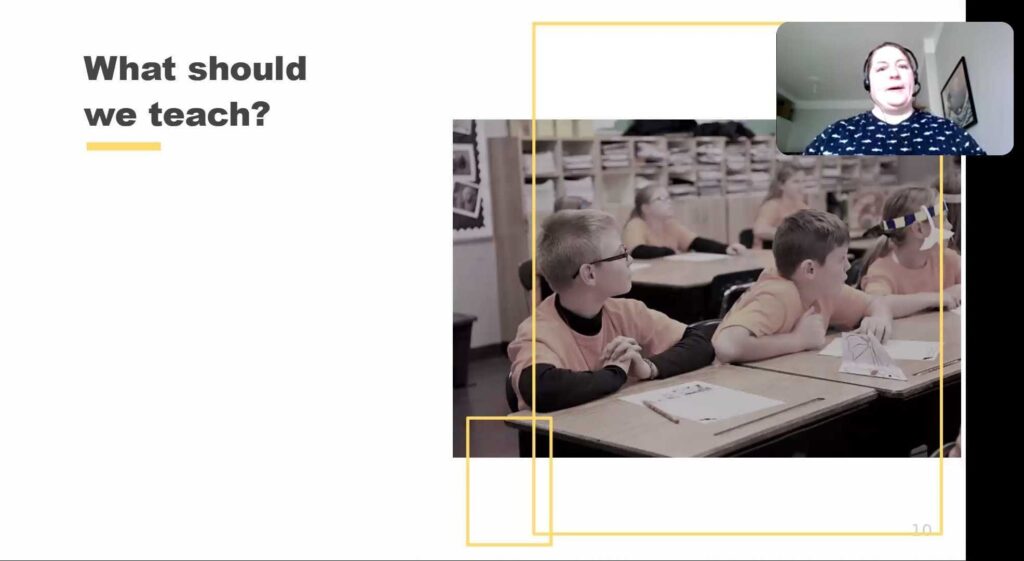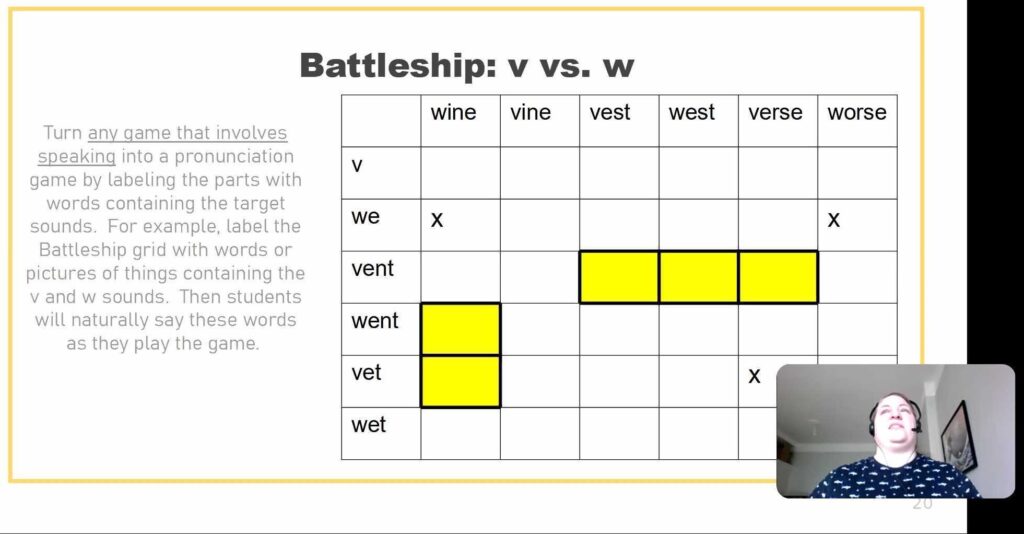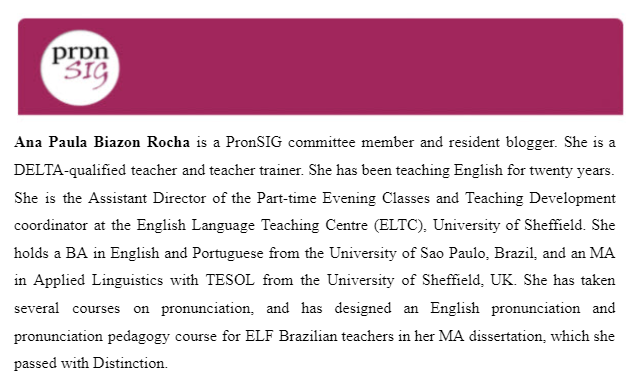by Ana Paula Biazon Rocha
On 13 July 2024, Mara Haslam presented PronSIG’s most recent webinar titled Creative Pronunciation Teaching for Young Learners. Haslam works in the department of Language Education at Stockholm University in Sweden, and her research interests lie in the field of second language phonology. In this webinar, she provided a solid theoretical basis for pronunciation instruction for young learners and shared suggestions for classroom practice to meet their needs. Let’s revise and discuss two main points of her webinar.

Image 1: Webinar with Mara Haslam
1. Perceptual training for young learners
Haslam drew our attention to the relevance of listening training with regards to pronunciation teaching. The more learners practise and improve their perception skills, the more confidently they engage in communication because they can understand their interlocutors and reply accordingly. Thus, we should focus on:
a. Sound and meaning association
Rather than simply distinguishing which sounds they hear, we can teach young learners how to associate sounds with meaning. For example, they can associate the /p/ sound with popping a bubble, or the /s/ sound with the hissing of a snake. They can also associate the long /i:/ sound as in ‘see’ with the colour green, or the diphthong sound /aʊ/ as in ‘cow’ with the colour brown. In this way, we are supporting the development of young learners’ phonological awareness.
b. Variety of contexts and speakers
We should try and present the target sound in all the contexts it appears such as beginning, middle and end of words because it might vary. For instance, the /s/ sound is usually pronounced as such at the beginning and in the middle of words, e.g., sauce, sell, sun, master, mystery, and possible. However, it is pronounced as /z/ at the end of words such as his, was, moves, noise, or in the plural form of words that end in a voiced consonant sound such as dogs, eyes, and lions.
Haslam also suggested that young learners should listen to different speakers saying the same word / sentence so we can raise their awareness of accent variation. In other words, people do not speak English in the same way, and thankfully, they do not need to do so to be understood. A practical example is: the word ‘bet’ sounds like /bet/ in standard varieties such as Standard Southern British English and General American English. However, it sounds more like the word ‘bit’ in New Zealand English.
c. Repetition
Haslam reinforced that the language acquisition process is complex, so we should not expect perfection from our students (and I would add that we should not expect it from ourselves either!). Likewise, we should not get frustrated if they do not get it at first. Listening training should be frequent in our lessons because learners benefit from repetition. It can help them hear and identify what they are hearing more easily.
2. Fun classroom practice
Haslam also reminded us that when it comes to young learners, mixing learning and fun is key. Some of her suggestions to practise pronunciation with these learners are:
a) Games
Haslam mentioned that we can take any game that involves speaking and that people usually play for fun, e.g., board games, Battleships, bingo, etc., and turn it into a pronunciation game. Here’s an example of Battleships she created for her learners to practise the difference between the /v/ and /w/ sounds:

Image 2: Mara’s Battleships
b) Tongue Twisters with a twist!
A well-known tongue twister is:
Peter Piper picked a peck of pickled peppers. How many pickled peppers did Peter Piper pick?
According to Haslam, these types of tongue twisters are not helpful for pronunciation teaching because they are designed to cause people to stumble by using similar sounds. Instead, she recommends the use of sentences that have many examples of the target sound, so learners can repeat the same sound many times. Some of her examples are:
- Chester chew cherries and cheese in the churchyard.
- Jenny jumps joyously in her jeans with a jump rope.
c) Jazz chants
Jazz chants are a playful way to introduce essential pronunciation features such as stress, rhythm and thought groups (also known as pausing or chunking) to young learners. In fact, they are a great resource for active listening because learners can hear the pronunciation of words and phrases in the context of the chant, imitate them and repeat them. Haslam also highlighted that these chants often use common phrases and sentences, helping learners practise pronunciation in chunks rather than isolated words, which aids the development of fluency.
Here is an example of a grammar chant focused on modal verbs can and can’t which can be used to focus on stress: in affirmative sentences such as ‘I can paint’, we stress paint as the main content word, not the modal verb ‘can’, which is a function word. Conversely, in negative sentences such as ‘But he can’t do my homework’, we stress can’t because of its negative meaning.
Haslam then concluded her presentation by emphasising that young learners need a lot of exposure to English as well as perceptual training, and that pronunciation teaching should start from the beginning: the earlier, the better.
As a final remark, although she focused on young learners, most of the tips and ideas she shared with us are definitely applicable to teenagers and adults too. They all need extensive exposure to English and frequent listening training to improve their oral skills. More importantly, they also benefit from learning and having fun at the same time. This is extremely enriching for their language learning process.
You can check previous blog posts here. Don’t forget to leave your comments below and follow us on social media.


